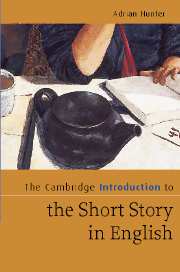Book contents
- Frontmatter
- Contents
- Acknowledgements
- Introduction
- Part I The nineteenth century
- Introduction: publishers, plots and prestige
- Chapter 1 Charles Dickens and Thomas Hardy
- Chapter 2 Rudyard Kipling and Joseph Conrad
- Chapter 3 The Yellow Book circle and the 1890s avant-garde
- Part II The modernist short story
- Part III Post-modernist stories
- Part IV Postcolonial and other stories
- Notes
- Guide to further reading
- Index
- Titles in this series:
Chapter 3 - The Yellow Book circle and the 1890s avant-garde
Published online by Cambridge University Press: 05 June 2012
- Frontmatter
- Contents
- Acknowledgements
- Introduction
- Part I The nineteenth century
- Introduction: publishers, plots and prestige
- Chapter 1 Charles Dickens and Thomas Hardy
- Chapter 2 Rudyard Kipling and Joseph Conrad
- Chapter 3 The Yellow Book circle and the 1890s avant-garde
- Part II The modernist short story
- Part III Post-modernist stories
- Part IV Postcolonial and other stories
- Notes
- Guide to further reading
- Index
- Titles in this series:
Summary
Ever since it first appeared in 1894, the Yellow Book has been a by-word for fin-de-siècle decadence and literary avant-gardism in England. Published by John Lane and edited by Henry Harland, it was marketed from the outset as a product for the discerning consumer, its bright yellow hardback casing, high-quality, spaciously margined paper and risqué illustrations making it look and feel distinctly ‘adult’, and quite unlike any other title on the crowded late-Victorian magazine shelf. Lane's wish, somewhat forlorn in retrospect, was for a periodical that would appeal to a highbrow readership but which would sell widely enough to return a profit against its exorbitant production costs. Harland's overriding concern, on the other hand, was for the quality of the content, especially the verse and prose fiction – so much so that he was willing to subsidize the venture out of his own pocket. The reality that quickly faced both men was a magazine market more complex and fickle than they had ever imagined, and while Lane delighted in the strong sales that notoriety and the whiff of licentiousness early brought, it was precisely the suggestion of luridness that caused the serious writers whom Harland wished to attract (among them Henry James) to want to distance themselves from the journal, and this would eventually prove fatal to the venture.
- Type
- Chapter
- Information
- The Cambridge Introduction to the Short Story in English , pp. 32 - 42Publisher: Cambridge University PressPrint publication year: 2007



